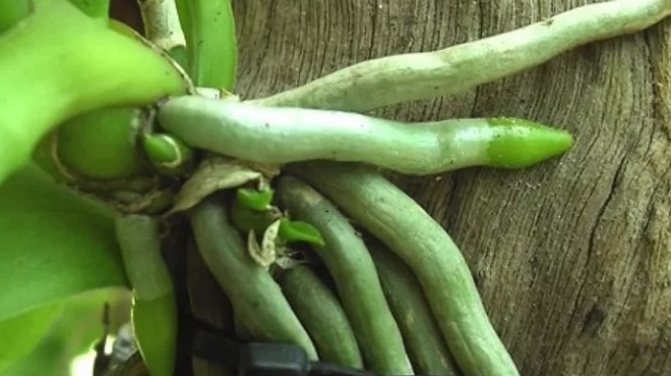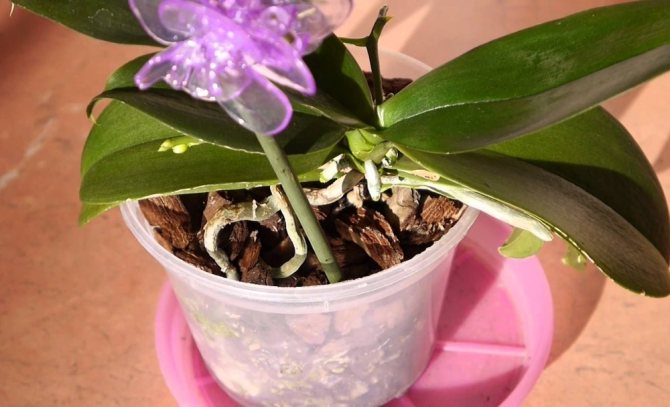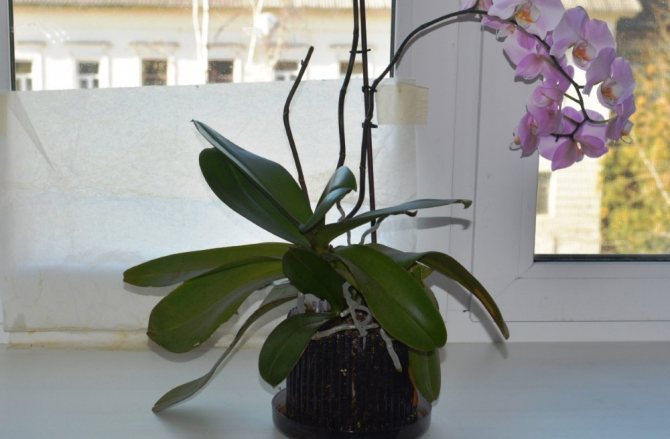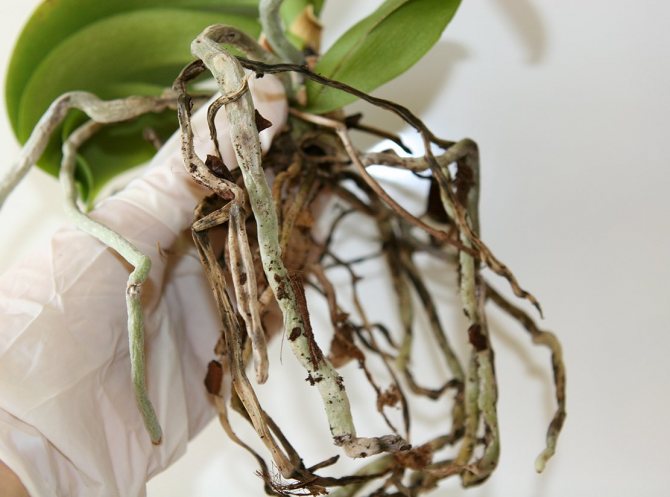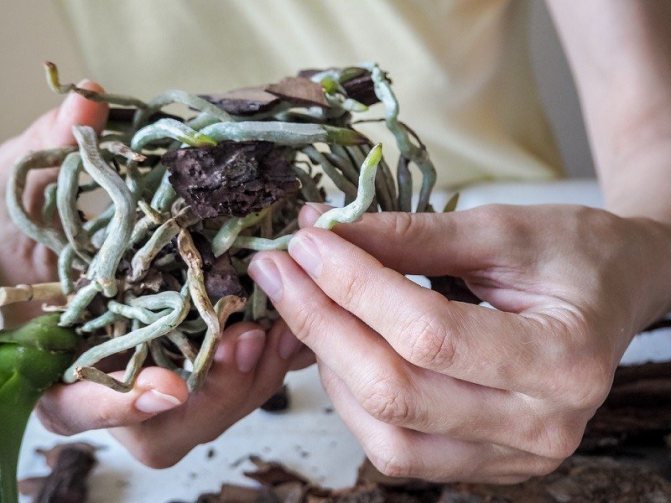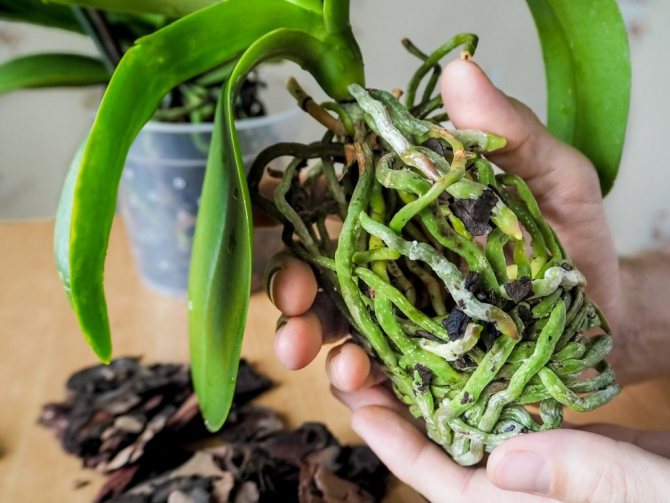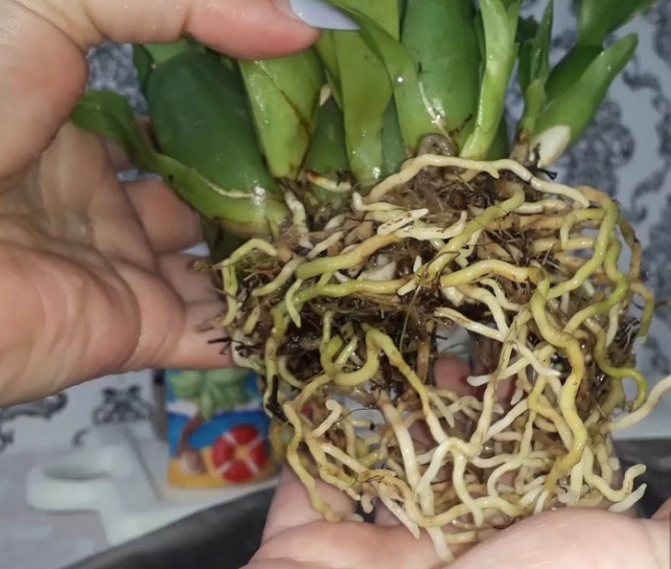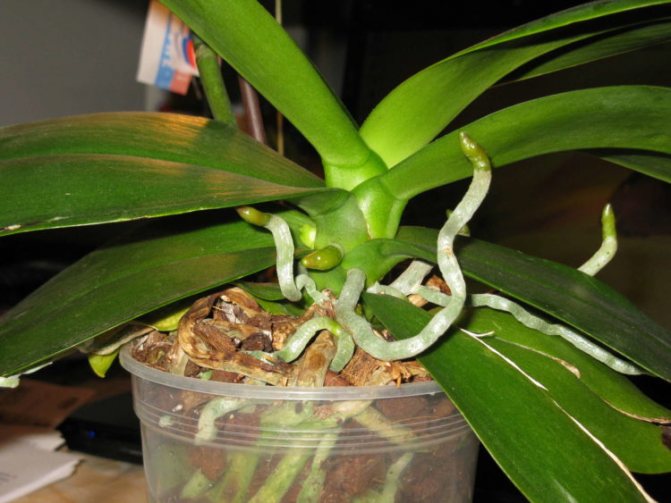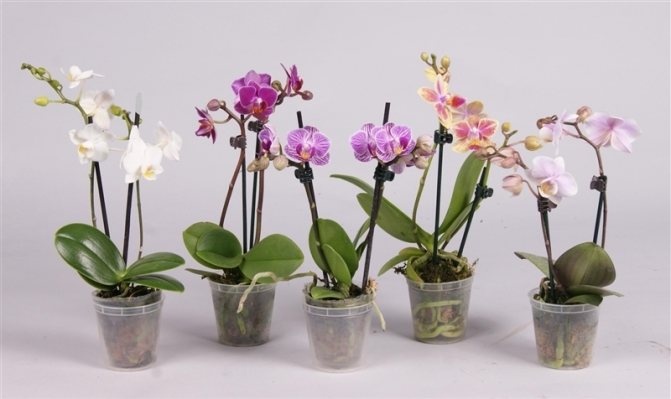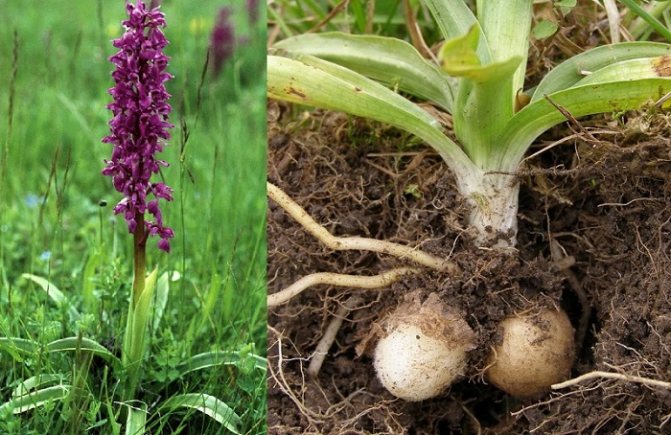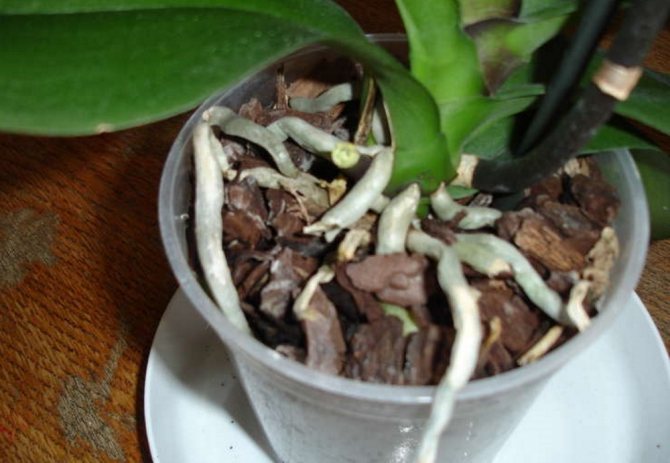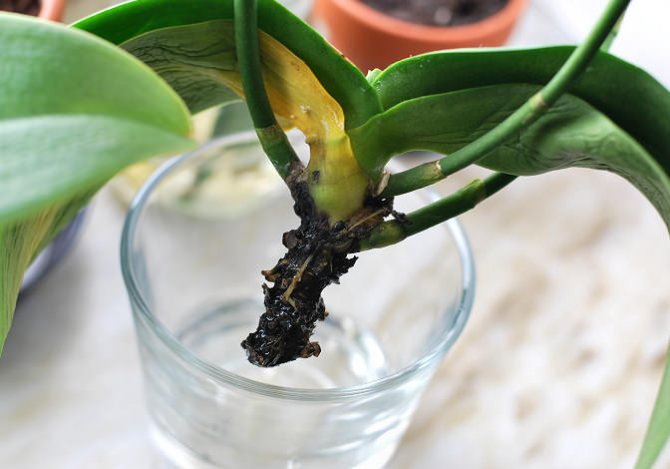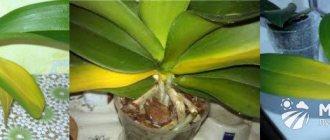Many budding florists worry that the roots of the orchid have crawled out of the pot. Do not be afraid of this. The fact is that the orchid belongs to epiphytes, which in the natural environment often grow on trees, clinging to them with roots. With a lack of nutrients, the tropical beauty begins to grow new roots, looking for a way to food. If the roots of an orchid come out of the pot, do not rush to prune them. In the article, we will tell you which roots and when need to be removed, and which should not cause you concern.
Orchid aerial roots facts
number
Experienced growers understand that when choosing an orchid, it is important to pay attention not only to the beauty, color and number of flowers, but also to carefully examine the roots of the plant. They should look healthy - both aerial and root roots located inside the pot. Due to the transparent material, the root system of the plant is very clearly visible, so when buying it is easy to understand whether the roots are dry or have a healthy appearance, whether there are signs of rot.
Sometimes inexperienced buyers are intimidated by the abundance of aerial roots. This is not a disease, but a variant of the norm, due to the characteristics of the plant. The natural habitat of the beautiful orchid dictates its own conditions, because luxurious flowers grow on trees, on rocky rocks, in gorges. The aerial root allows the plant to receive all the nutrients necessary for growth and flowering, most of which it takes from the environment. Surprisingly, the air also contains moisture nourishing flowers, without which orchids die.
A large or small number of aerial roots is completely irrelevant. The main thing is that the root system has a healthy appearance. And it is by external signs that an experienced florist will always be able to determine what the plant lacks. The root system reacts to the irrigation regime and maintenance conditions with its appearance and condition, you just need to learn to read the signs that it gives.
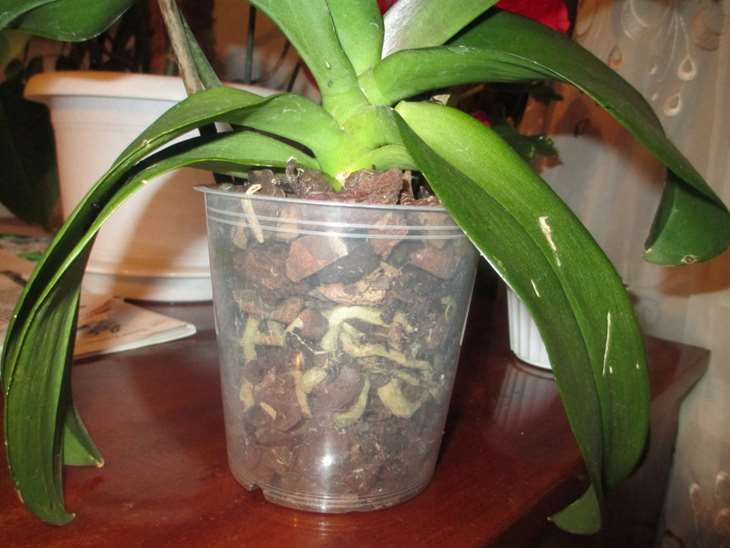
Features of the structure of the root system
The air roots are quite thick and have a cylindrical or flat shape. They are covered with a shell that resembles a sponge in texture. Due to such a sponge, moisture is saturated, which the plant receives from fog or rain. And on sunny and hot days, this shell prevents it from drying out - under it are vascular-type bundles, which serve as a kind of water reservoir.
This root sheath is called velamen. It has a green tint when wet, and when dry, its color is silvery gray. It is easy to determine the stage of growth by color - young roots are distinguished by a bright light green color, and in the old root system, the shade is already faded, muffled.
Advice! Watch closely for new light green roots. If they are not visible for several months, you need to revise the care of the houseplant and the schedule for its irrigation.
Common problems
Orchids are delicate, beautiful, but very capricious plants. Caring for them is not easy and often a lot of hassle.And if experienced florists are already accustomed to the whims of a tropical beauty, beginners at the initial stage have a lot of questions:
- Why is the root system rotting?
- Why do the roots dry out?
- What to do with aerial roots that grow back fast enough?
- Is it possible and necessary to cut the aerial roots of an orchid?
This is one of the most common problems. It is associated with the wrong irrigation regime. After all, it is important not only the correct amount of moisture intake, but also the temperature regime in which the "beauty" is contained.


Watering the orchid should alternate with periods of drying the roots. A tropical flower, contrary to popular belief, does not like to be constantly in a humid environment, and in the absence of heat, it needs watering even less often than in summer. From time to time, the plant needs to be replanted - the old soil is able to retain moisture and at the same time slows down the air circulation, which creates excellent conditions for rotting.
What to do when the roots dry
Often, the air roots of an orchid dry out - a situation opposite to decay, provoked also by an incorrect irrigation regime or active fertilization of a beauty. Modern fertilizers have a high concentration of chemicals that can cause burns. Drying is also observed as a result of watering with low-quality, heavy water saturated with salts and heavy metals. Of course, a lack of water during a hot period can easily lead to sad consequences in the form of drying out. This once again confirms that the irrigation regime should be moderate and thoughtful.
Another problem is the large number of aerial roots.
And novice growers are wondering - is it possible to cut them? Yes, you can, but only if it is rotten, dry processes or a root system with signs of dying off.
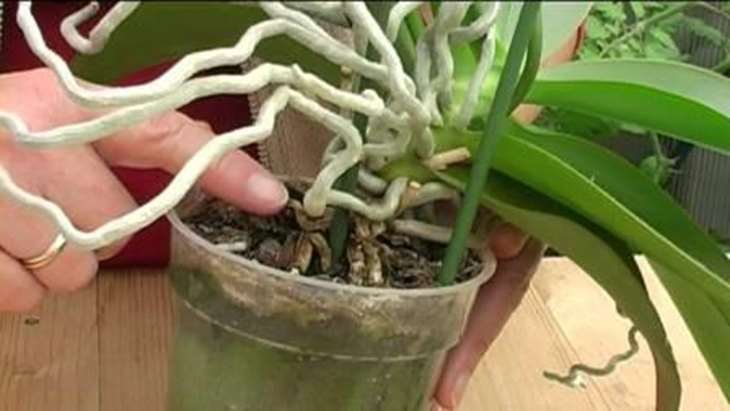

Use a knife or sharp scissors to remove. The instrument must be pre-disinfected with an alcohol solution to avoid contamination of healthy tissues. It is important to carry out the removal carefully, freeing the plant from dead elements. The slices are sprinkled with charcoal, you can use activated charcoal from the pharmacy, ground into powder.
Read also: How to care for orchids at home after buying in a pot: step-by-step instructions on what to do with them, when they brought them from the store, a photo of a flower
After the procedure with aerial roots, the tropical beauty cannot be watered for several days, since with careless watering, decay can again be provoked in healthy areas. Despite the fact that the orchid is considered a fairly tenacious plant, it is very difficult to leave it without a root system. Therefore, it is better not to allow the complete removal of the processes of a cylindrical shape, but to take measures at the first signs of the disease.


Do aerial roots need to be removed?
Sometimes the aerial roots of an orchid grow quickly and actively - what to do in this situation? The reason why an orchid has so many new growths is due to the increased dryness of the air. Most likely, the exotic is hot and the growth of new roots is trying to get more moisture from the environment.
To prevent such a process, you need to monitor the conditions of detention, especially in the winter. The problem is usually associated with heating radiators, which dry out the air in the cold season. And since flowerpots of florists predominantly live on window sills, the problem of dry air is very relevant here.
The best solution is to remove the plant from the radiators. There is no need to remove new roots, as well as shove them into a pot, which beginners often do. It is not necessary to transplant a young beauty, especially if the last transplant occurred not so long ago. The formation of new roots in phalaenopsis is a natural process.The only thing recommended is to cover the growths with moss to keep them natural. Humidity.
Keeping an exotic orchid with the right approach does not require special skills. The plant is distinguished by a huge thirst for life and even if problems arise, it should not be written off from the account. A little care, a change in the watering regime and conditions of detention will help to revive beautiful flowers, and the peduncle can even give the baby to the delight of the owners.
In water
Many experienced flower growers grow orchid roots in water. The options may also be different, so let's look at everything in order.
Alternating soaking and drying
With this method, external conditions are preserved:
- the flower in the container is in a lighted place (but not in direct sunlight);
- air temperature is provided + 25… + 26 ºC.
To immerse phalaenopsis in water, select a transparent container, set the plant so that the base of the roots is higher than the bottom.


A little water is poured into the bottom of the container every day in the morning so that the roots of the plant are in it. After 6-10 hours, the water is drained, leaving the flower in this state until the next morning. In the morning, the procedure is repeated again.
ON A NOTE! It is advisable to add special preparations (for example, root), fertilizers containing potassium and phosphorus necessary for the plant to the water.
Also, honey, sugar, glucose are added instead of them (no more than one teaspoon per liter of water).
Always in the water
Another method involves finding the plant in water constantly, while the liquid is changed every 5-6 days. This option is least suitable for orchids, since plants grow roots for a long time, often rot, and if they survive, they take root very poorly in substrates.
Above the water
Another way is to grow phalaenopsis roots above water. Similar to the first option, when drying and soaking is used, but in a different format. The plant is placed in a container with water, while the base of the roots is above the surface of the water and does not touch it. The container is closed from above.
Every day, the plant is taken out (for example, in the morning), soaked with roots in water with added sugar, then taken out, dried and placed back in a container above water.
IMPORTANT! Duration of soaking in sweet water - 60 minutes.
Up by the roots
A method is also used when not the base of the roots of the phalaenopsis is immersed in the water, but its leaves. To do this, you need to carefully place the plant in a container where water has already been poured. In this case, the leaves should be immersed in water only one third.
The base of the roots is in the air.
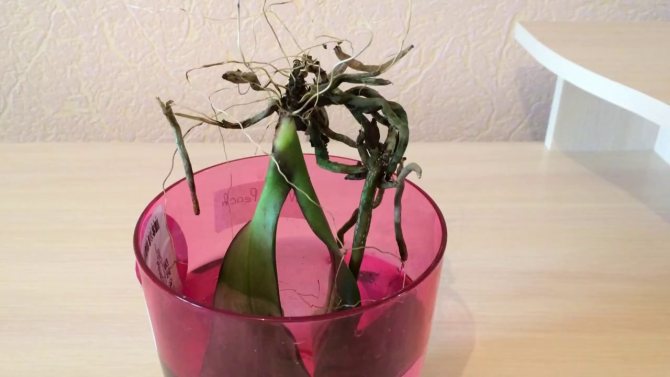

Every day, the upper part of the plant is irrigated with warm water from a spray bottle. After about 30-40 days, phalaenopsis will give the first roots.
ON A NOTE! Activated carbon must be added to the water where the leaves are immersed.
After the first roots appear on the base, the plant is placed in a transparent pot with sphagnum moss, where it will grow further. This option is convenient in that not only roots are actively growing in phalaenopsis, but new leaves are preserved and even appear.
In the substrate
Very often, flower growers reanimate the phalaenopsis roots not in water, but in special substrates. Many people say that this option is more suitable for plants that have at least small (2-3 cm) roots. But for plants without roots, growing in a loose substrate can also be successful.
The general rules are as follows:
- any substrate for phalaenopsis should be moist (but without excess moisture content);
- it is useful to spray orchid leaves for better growth with a special solution with vitamin B1.
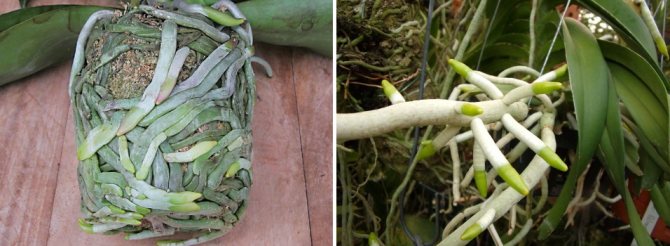

Types of substrate for growing phalaenopsis roots:
- bark (using materials of a fine fraction, which must be well steamed and dried);
- a mixture of fine expanded clay, crushed bark, sphagnum (expanded clay is used as a drainage layer);
- tightly rammed sphagnum.
If the plant was completely devoid of roots, then it will take a long time to wait for regrowth - up to 10-12 months. Phalaenopsis, which have at least tiny roots, the process is faster.
You may be interested in: How to care for orchids in a pot after purchase Why orchid leaves wither and how to save it Features for the care and reproduction of Dendrobium Nobile orchids
On the bark
This method is rarely used, since the plant needs to create optimal moisture values. In dry air, roots will not grow.
Phalaenopsis must be fixed on a piece of bark, to stimulate growth, treat the plant with a special solution with vitamin B1. There is no need to water or even spray the flower.
Roots will take three months to appear, but it is quite possible that there will be a longer wait.
What to do if the roots of an orchid grow up and why is this happening?
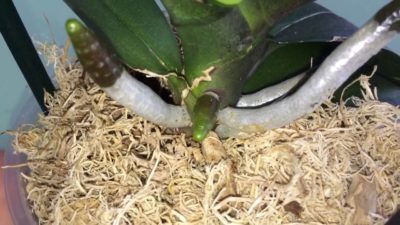

You have noticed that the roots of your orchids have begun to grow upward - do not be alarmed or panic. Your plant is fine. One of the features of orchids is aerial roots.
What it is, why such a phenomenon occurs and how to care for a plant with such roots, you will learn in our article. we also recommend watching a useful and informative video on this topic.
Photo
Below you can see in the photo how healthy roots from the orchid family look:
What it is?
You surely know that in nature, an orchid can grow on trees and other plants, while it does not parasitize... That is why the flower uses only the aerial root system. They contain a special layer of cells with which they absorb moisture. It is called velamen. This way of existence is called an epiphytic form of existence.
Home orchids are adapted to mixed soils, so we do not see roots on the surface. But, nevertheless, the appearance of several of them on the surface is a normal phenomenon. The root system provides a guarantee of a healthy and beautiful flower. The roots can be of different shades of green. The root system of these plants is very sensitive. If there are any problems with them, this will immediately affect the appearance of the flower.
How to distinguish a healthy root system from a diseased one?
The first condition for a healthy root is firmness and firmness. And accordingly, on the contrary, if the root is soft, it breaks when pressed or dents remain, most likely it is not capable of functioning.
External signs of a healthy rhizome:
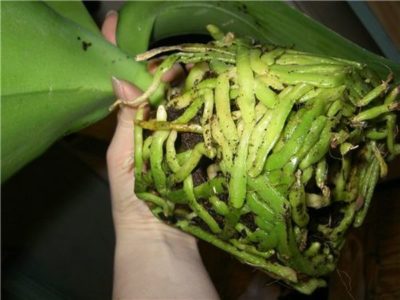

smooth structure;- fleshy;
- density;
- green, although the color may change when interacting with the substrate or mineral fertilizers.
Experienced growers suggest checking the condition of the root system, not only based on external signs, but also empirically.
To make sure that the root system is alive, you need to pull the plant out of the flowerpot and submerge the lower part in water. Get it in 2-3 hours. Viable roots will acquire the above characteristics. If the sprouts remain sluggish, pale - feel free to remove.
Watch a video about healthy and diseased plant roots:
Why wrong growth?
It is important to remember that if the roots in the substrate are healthy, then it does not matter how much it grows outside. This does not harm the flower. This phenomenon appears due to:


Over-watering - because of him, the plant dies and so that this does not happen, in this way the roots are saved from death.- Insufficient watering - in search of moisture, the roots are looking for it outside.
- Lack of light - because of it, the roots rot and to find it outside the pot, they climb out.
- Dense soil - because of it, the plant becomes cramped. Also, such a habitat can lead to root rot.
- High temperature content - leads to drying out, from which the roots and crawl out in search of moisture.
Rubric: "Question - answer"
Question number 1... From a friend I heard about feeding the orchid with sugar. I sprinkled it in a pot, waited a week, but, in my opinion, nothing good happened. Why is that?
Perhaps something went wrong. Remember if you watered the substrate before and after feeding. If the crystals got into a dry environment, they did not dissolve for a long time, which means they did not work. Another time, water the orchid well before adding sugar. It is likely that the result of feeding will appear not earlier than after 2 weeks.
What can it lead to?
With proper care, they are completely harmless, but if you have violated the rules of care, then this can lead to various problems.
Drying is carried out:
- insufficient watering - they do not receive as much moisture as the roots in the substrate, from this they dry out;
- trauma - during transportation or transfer;
- burn - from an overdose of fertilizer or poor quality water;
- dry air - because of the hot air, they will shrink and dry out;
- fungus - the last stage of a fungal disease, before that the roots in the hill and the leaves of the plant will die.
Read also: Black Orchid
To solve the problem, it is necessary to remove the damaged areas and sprinkle with charcoal or activated carbon. If the room is dry, spray and water on time.
Mold growth
Low temperatures, excessive watering and a lack of light lead to mold growth of orchid roots.... If the mold has not passed from the substrate to the roots, then:


loosen the top layer of the substrate;- dry;
- water only after complete drying.
If the mold has moved to aerial roots, then:
- get the flower out of the ground;
- Rinse;
- soak for 25 minutes in a solution of fugicide;
- plant the plant in new soil.
Redness of the tips
It is not a disease or a problem. Redness of the tips is a simple indication of root growth.
Stiffening
Severely hardened roots are old. This is a natural process. So that they do not become the cause of pathogenic bacteria, gently trim them.
Air roots "rust" or turn black
Blackening of aerial roots is a manifestation of salt deposition... This means that the roots inside the pot do not have time to drink water. Low humidity can make things worse. Therefore, you need to act quickly:
- Place the plant on a wet drain pan or increase the humidity with a humidifier.
- Do not place the plant in direct sunlight or near batteries.
- Water with soft water only.
- To prevent the appearance of slugs or snails, transplant the plant into new soil.
Watch a video about the causes of "rusting" and blackening of orchid roots:
The appearance of patches of pink or red hues
There are two reasons for the appearance:
- In the hot season, as a kind of tan.
- The consequences of fusarium.
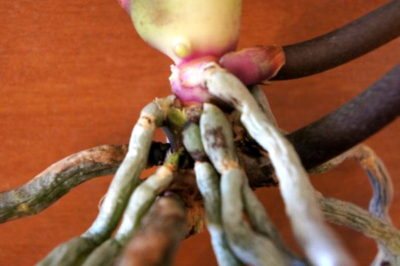

Pink patches on the roots are not a disease and do not need to be treated... And fusarium is a dangerous fungal disease and must be treated. Leads to wilting of roots, stems and leaves.
- watering frequency;
- damp weather;
- high humidity.
- Remove the plant from others.
- Eliminate contaminated parts.
- Disinfect the sections.
Proper and improper home care
It is important to take care of an orchid competently, always know what to do with the roots of a flower, it is important for its health and flowering. Do not worry if the aerial roots of the plant hang over the pot - this is absolutely normal. With quality care, their growth will stop.
| Correct | Wrong |
| Moisten the flower only after the substrate is completely dry. | Organize watering on specific days, dates, regardless of the state of the soil. |
| Use soft, clean water. | Use water for irrigation, regardless of quality. |
| Mandatory drainage layer. | Lack of drainage in the flowerpot. |
| Use for an orchid of a lightweight, plastic pot.It will provide an opportunity to visually inspect the root system and will not interfere with the process of photosynthesis. | The use of an opaque, ceramic flowerpot. |
| Choose a soil specifically for orchids, according to the requirements for the substrate. | Use garden soil for planting. |
| Do not overheat the phalaenopsis root system. | Place the plant on a windowsill, near heating radiators. |
| Apply mineral fertilizers to pre-moistened soil. | Fertilize dry soil. |
| On clear, hot days, shade the flower to avoid sunburn. | Place the orchid in direct sunlight. |
What if you got out of the pot outside?
Several orchid roots that have crawled out of the pot are the norm.... But a large number of them speaks of improper care and it needs to be revised:
- You don't need to trim them.
- Control the amount of light.
- Adjust watering.
- If the plant is cramped, transplant it.
Transplant orchids in early spring or after flowering... If the tips of the roots have turned bright green, then this means that they have begun to grow. Wait until they grow back a little. When replanting, be very careful - the roots are very fragile.
- Before removing the plant from the pot, dip it in water so that the substrate is soaked and the flower can be easily removed.
- When removed from the pot, rinse the roots from the old soil.
- Examine the roots for decay and dry spots. If there are such, cut and process the slices.
- Plant in new soil.
How is moisture obtained?
This process is very interesting and worth considering point by point:
- during rain or fog, water enters the root surface, and the dry membranes of velamen cells swell;
- lamellae - water stripes are formed on the inner walls of the velamen cavities;
- the lamellas gradually merge under the influence of gravity and surface stress;
- large "droplets" are drawn inward and displace air.
From the cavities of velamen, water enters the exoderm. The exoderm in orchids is also unusual: it does not consist entirely of dead tissue, but has sections of living cells, the so-called "passages". "Throughput" cells and deliver water to the axial cylinder.
Why are orchid roots such an unusual and, at first glance, impractical velamen layer?
- In most species, it has a lot of thickness and density, and protects the root from external influences.
- Fungi and microalgae settle in the cavities of velamen, helping the plant to process salts of phosphorus, potassium and other useful substances.
Reference! In the normal, dry state, the root of the orchid has a white-silver color, and when moistened (for example, immediately after watering) it becomes bright green. This is due to the fact that when moistened, the velamen layer becomes translucent, and through it you can see the exoderm with chloroplasts.
Features of the structure of the roots
Aerial roots in an orchid are the norm, and not, as many think, a disease. An orchid with developed aerial roots is often found in the wild.
In nature, these plants often grow on trees. Therefore, such roots perform the following functions here:
- fixation on the substrate;
- food with substances that are in the air.
Air roots in this variety of indoor flowers appear when certain conditions and care are created. At home, a large number of such roots indicate insufficient care.
Aerial roots are thick flat or cylindrical outgrowths. From above, they are covered with a shell resembling a sponge. Thanks to her, the roots are able to absorb moisture from the air. On sunny days, this spongy membrane dries up to prevent moisture loss. Such a shell is called velamen. When wet, it is characterized by a green color. Green roots are characterized by the presence of chlorophyll or symbiotes in their structure.With the help of chlorophyll, the roots are able to take a direct part in photosynthesis.
In the dried state, the velamen is white or silvery-gray. Young roots are bright light in color. In older processes, the color becomes faded.
Vascular bundles are located under the spongy membrane. They act as a reservoir of water. With the help of such vascular bundles, water is delivered to the leaves of the flower.
Read also: How to save orchids? Orchid diseases and their treatment
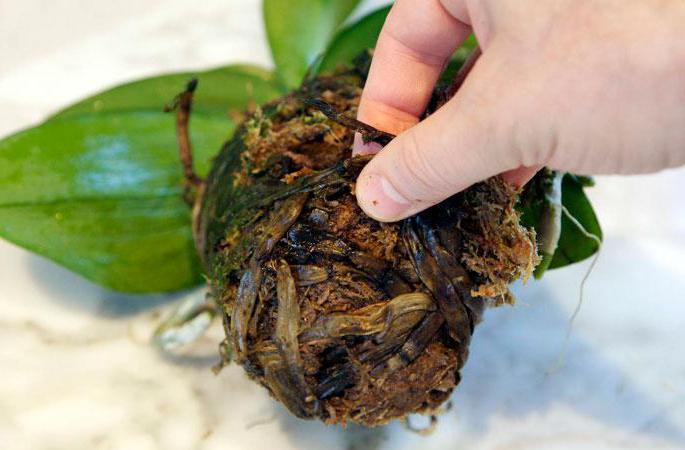

Normally, the flower should form new roots within a couple of months. If this does not happen, then care should be changed. The situation will also be bad if the orchid has a lot of aerial roots. It is especially important in both cases to pay attention to watering and irrigation of the plant.
Greenhouse
To reanimate the roots of phalaenopsis, it is necessary to create greenhouse conditions (and this is not for a catchphrase, but just like that). At home, the role of a greenhouse can be played by:
- a cut-off bottle made of ordinary plastic (it is better to take large containers, 5 or 10 liters);
- aquarium.
The essence of the method is that conditions are created for orchids in which they grow in nature: warmth, diffused lighting, optimal moisture indicators. The greenhouse is placed in a well-lit place, but at the same time, hot sunlight is avoided.
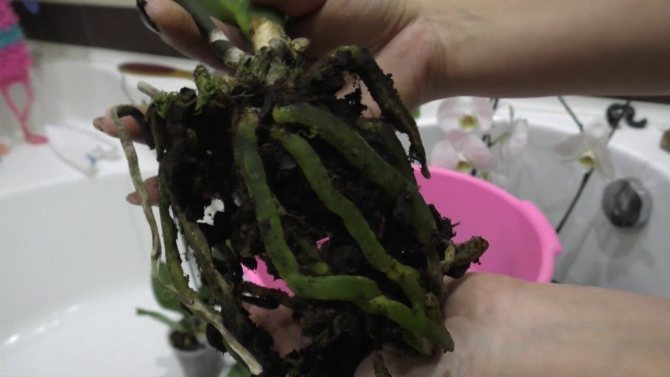

The optimum room temperature should be around + 22ºC… + 28ºC. A little expanded clay is poured inside the container, sphagnum is laid and phalaenopsis is placed on top. The place where its roots grow should be in the moss.
Every day, an impromptu greenhouse is ventilated, and to keep the humidity level stable, a glass of hot water is placed inside the bottle or aquarium.
When using the "greenhouse" methods, phalaenopsis can give the first roots in about two weeks. If done correctly (and the process can take from one month to a year), the orchid will give good strong roots. When their length is about 4-5 cm, the phalaenopsis can be taken out of the greenhouse and planted in a pot.
The reason for the appearance of aerial roots
Phalaenopsis can have multiple roots for a variety of reasons. To solve the problem of too intensive growth of the root system of the plant, you need to know why the orchid began to form aerial roots.
You can get such an abundant spine overgrowth in the following cases:
- High room temperature. Especially often, too active growth of aerial roots in orchids is observed in winter, when the pots standing on the windowsill are heated by batteries. The radiator not only heats up the container, it also dries the air.
- Excessive watering. If the orchid has a lot of moisture in the pot, then the plant, in order not to die, will begin to actively form additional roots. Otherwise, putrefactive processes will appear in the substrate.
- Lack of moisture. This situation is the second extreme of improper care of phalaenopsis. Lack of moisture appears in dry rooms and with infrequent watering.
- Lack of lighting. Since the roots have a photosynthetic function, when there is a lack of light, the shoots will begin to grow in order to capture more light. Otherwise, the roots left in the pot will start to rot, making it impossible for the plant to feed through the substrate.
- Dense substrate. For the land in which the orchid grows, special requirements are imposed. For example, do not pack the substrate too much. This will lead to cramped conditions as well as worse drying out. And this is a direct path to root rot if they remain in such a pot.
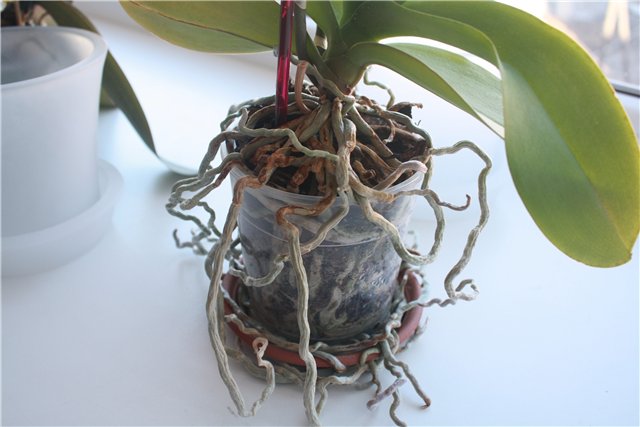

However, excessive root outgrowth should not be regarded as a pathological condition. Therefore, in most cases, you do not need to fight them. This is just an excuse to reconsider the care of the flower, as well as to change the scheme of its irrigation.It is necessary to take emergency measures only when the roots are affected by infection or parasites.
Phalaenopsis resuscitation
Not always everything is so deplorable and it happens that the phalaenopsis has several tiny roots. Then it is simply transplanted into another container with mandatory fixing.
If most of the roots (up to 95-98%) are absent, you will have to try to reanimate the flower. In most cases, if you do everything right and have patience, the phalaenopsis will become obsolete, its root system will grow back, and it will again delight you with flowering.


Several different methods are proposed for resuscitation of orchid roots, while a number of preparatory measures must be taken:
- prepare a cutting tool (with mandatory disinfection with alcohol);
- carefully peel the roots of the flower, remove all damaged and rotten parts, leaving only a living root;
- it is imperative to treat all cut points on the roots with a special powder fungicide or crushed charcoal.
ON A NOTE! You can use regular cinnamon for root cuttings.
.
If the plant has dry or slightly wilted leaves, you do not need to prune them. You can cut the peduncles, leaving only the lower part of the arrow.
What to do
What to do with the aerial roots of an orchid? This question is asked by novice growers, having discovered their growth by looking into the pot. In this case, you need to do two things:
- find out the reason for the abundant growth of roots;
- correct the situation - normalize care. For example, you can remove a flower from a heated windowsill or place it in a well-lit place.
After the changes have been made, it remains to wait until the flower returns to normal. If only a couple of air roots remain in the pot, then the cause has been identified correctly.
Many people ask if it is possible to remove excess roots that have grown too much outside the pot. This is a very bad decision as it will injure the flower. In addition, the cut root can contribute to the introduction of pathogenic microflora. Also, such pruning will lead to the fact that the shoot will not be able to fulfill its duties to provide the plant with nutrients.
The easiest way to get rid of extra roots is by changing the water regime. If after that the situation has not changed, you can try to transplant the orchid into a new pot.
To resolve the issue, it remains only to choose the right container and a new substrate. The soil remaining after transplanting should be thrown away, since it will already be poor in nutrients. In this case, you can cut off rotten and damaged roots. The remaining roots must be carefully transferred to a new pot.
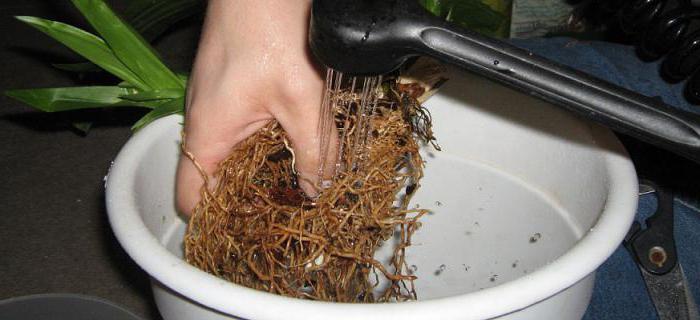

During the transplant, the roots are carefully removed, washed, disinfected and placed in a new well-watered substrate, already prepared in a larger pot. Watering the transplanted flower can be carried out only after the substrate has time to completely dry out.
General information
The root system of indoor orchids is significantly different from the structure characteristic of other plant species. Orchids can be found growing in the ground and called lithophytes. In addition, there are epiphytic orchids, which can be distinguished by the presence of "aerial roots".
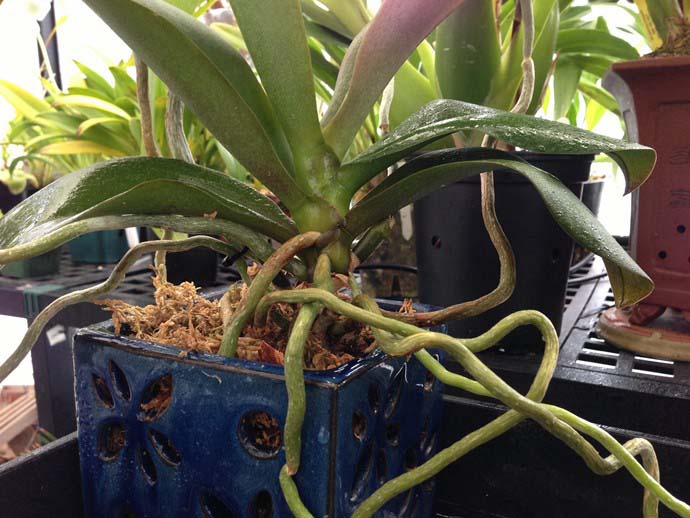

Root system of lithophytic orchids similar to other indoor plants. The main difference is represented by the fact that orchids are capable of not only absorbing moisture by their roots, but also storing nutrients. There are a number of lithophytic orchids in which the functions of roots are performed by some kind of nodules. Such parts of the plant take an active part in the process of feeding the indoor orchid in winter.
Root system of epiphytic types of orchids has a completely different structure and is characterized by significant thickness.Most of the root is represented by velamen, which consists of hollow and dead cells. The presence of velamen allows the root system to use various natural components as moisture, represented by rainwater, dew and even fog. The plant can do without moisture for a long time. In addition, this layer protects the root system from overheating.
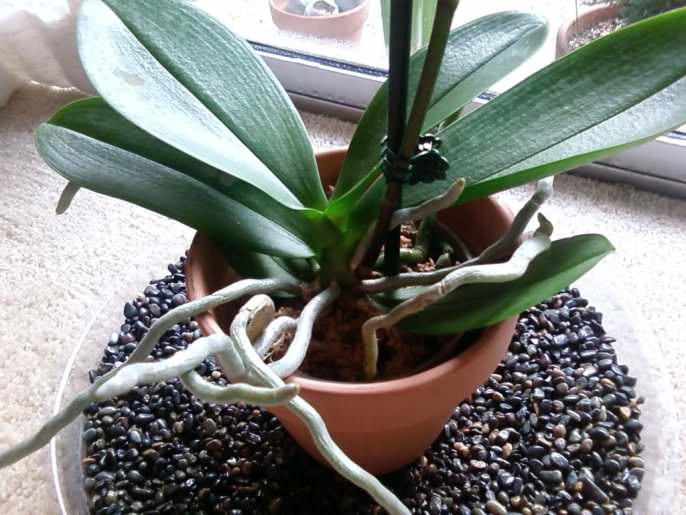

Choosing the right filler
Another reason for the appearance of air roots in phalaenopsis is an incorrectly selected substrate. Such flowers can only be grown on a special earthen substrate consisting of moss and bark. Other types of soils are not suitable here, since they are too dense and the root system of orchids in them will not be able to grow, develop and fulfill their direct duties. It is best to purchase the substrate from a flower shop.
Now you know why orchid aerial roots form and what to do with them.
How to grow roots in phalaenopsis
As you can see, it is not so difficult to grow roots in this orchid, which is quite common in home floriculture. The methods are quite affordable, and with the correct execution of all actions and the presence of patience, the flower will certainly thank you with its flowering.
To obtain a good result, it is necessary to use special preparations to stimulate root growth. All of them are sold in specialized stores, and warm clean water is used to prepare solutions.
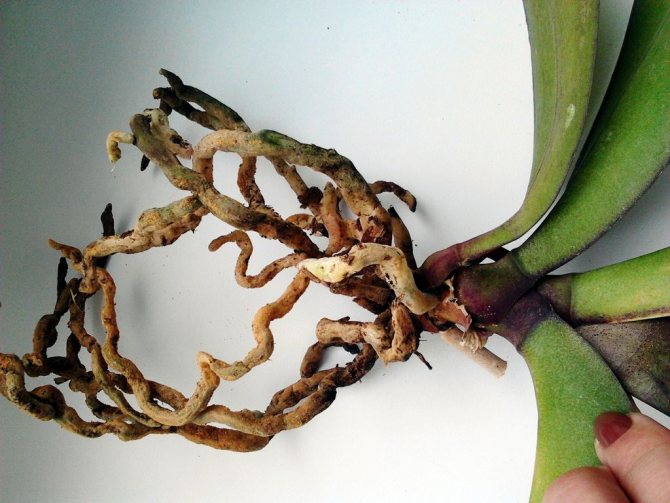

Ribav-Extra
It is positioned as a root-forming agent, used to treat plants, and also as an anti-stress agent.
Allows you to increase productivity, germination of seed. In the case of phalaenopsis, it stimulates root formation, promotes better plant survival.
Used for orchids: add two drops of the drug to a liter of water.
Zircon
It is a universal drug that is used to enhance plant growth, stimulate root formation. Included in the group of phytohormones, it is considered an effective feeding. The preparation is based on an extract from the Echinacea purpurea plant.
Application for phalaenopsis: four drops of the drug are diluted in a liter of water.
Radifarm
A special preparation based on various herbal extracts. It stimulates the growth of roots, increases the rooting of plants, increases their survival.
For an orchid, a composition is used: one drop of Radifarm is diluted per liter of water.
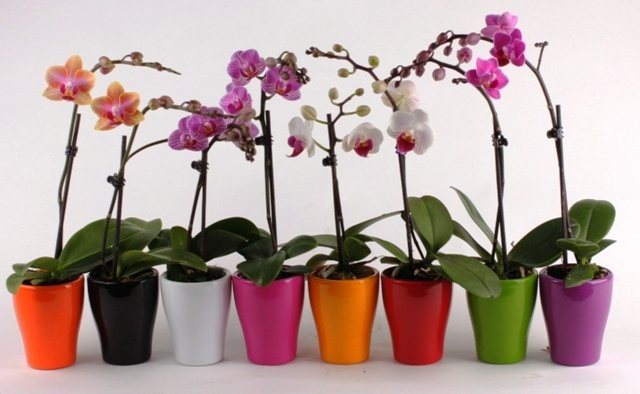

Etamon
It belongs to the drugs of a new generation, is a stimulant of root growth, provides the plant with rapidly assimilated forms of nitrogen and phosphorus.
For an orchid, the following composition is used: one ampoule of Etamon is taken per liter of water.
Symptoms of problems
If something is wrong with the orchid, it will definitely signal this with its appearance. It is worth sounding the alarm and taking action if you notice the following signs:
- Slow and poor growth.
- Leaves on the entire stem wilt and dry. After that, they usually turn yellow quickly, and the flower itself dies. But don't worry if only the lower leaves wither. This is a normal process for an orchid.
If the listed symptoms are not observed, then it is better not to disturb the plant again. Otherwise, the natural development will be disrupted, and then the resuscitation of the orchid will definitely be required.
Tools and fixtures
To remove diseased and dried roots, flower growers will need the following tools, substances and devices:
- Scissors or secateurs. These devices should be sharp enough to nibble on shoots of varying thickness from the first press.
- Ethyl 96% alcohol or other antiseptic for processing instruments. It is also allowed to use fire or natural products.
- Rubber medical gloves. This product not only protects the skin of the hands, but also protects the rhizomes from contact with human body fluids.
- Powdered charcoal or activated charcoal.These substances will help protect the cut areas of the shoots from drying out and penetration of pathogens into open sections.
Also, when carrying out work, you will need an oilcloth and any detergents to disinfect the pot. If the container has become cloudy and an indelible plaque has appeared inside, then it will have to be replaced with a new one.
Step-by-step instructions for pruning
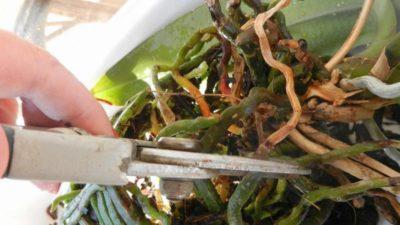

Orchid root pruning is a healing procedure, which is carried out when it is at rest, i.e. faded. After spending it, the florist redirects nutrients from putrefactive areas to healthy ones.
Rotting is the process of destruction of organic nitrogen-containing compounds under the action of microbial enzymes. If one of the roots of an orchid is affected by rot, other areas will soon become infected. Refusing recreational activities, he pushes her to a quick death.
Before cutting off a suspicious-looking part of the plant, cut off a small piece from it with a pruner. They are examining him. If its color is white, do nothing with it. Only shriveled, brown and decaying processes are cut off.
Instrument preparation
When pruning, the grower uses a knife or pruner... He must prepare the instrument before use. Without doing this, they are not surprised to get an infection. For disinfection, wipe the cutting part of the tool with alcohol. Manicure scissors are not the best choice when you need to cut a green pet. Often, delicate leaves are damaged by them.
Find items to shorten
Before proceeding with the procedure, the roots are examined. Remove those that have dried up or started to rot. They differ from healthy ones in that they do not change their color as the substrate dries in the pot: they are always brown.
The process itself
- Take the orchid out of the substrate... This is easier to do when the substrate is dry, i.e. it is undesirable to water it before the procedure.
- After removing the plant from the substrate determine which roots rotand which ones are not. Rotting processes of brown color.
- Finding rotting roots prepare the clipping tool... It is treated with an alcohol solution so as not to infect the wound.
- After preparing the instrument cut off the problem area... If it is located at the bottom, only the rot is removed. If the root is damaged at the base, cut it off completely. If you do not cut it off like this, the fungal disease will develop with renewed vigor, provoking a new wave of decay in healthy areas. Another reason for performing this action: the capillary moisture from the environment enters the upper layers of the damaged root at the base of the root, but it does not reach the plant. Sooner or later, such a root dies anyway.


After cutting off the problem area process the places of cuts... Florists dilute the fungicide or make a manganese solution in a separate container and immerse the orchid in it for ten to fifteen minutes.- After processing the cut points the lower part of the flower is placed in a vitamin solution... When preparing it, they take one liter of water and dilute one ampoule of vitamins B12, B1, B in it and keep it in it for 10-15 minutes. 2-3 months after this procedure, new roots appear.
- Return the orchid to the pot, laying a drainage layer on the bottom and filling the voids with a new substrate.
How and how to properly process the flower after the procedure?
The cut is the wound. It is a common cause of tissue dryness and a place through which pathogens can enter the orchid. Without properly processing it, the flower becomes sick and dies. When pruning, the cut site is treated with one of the following substances:
- Crushed charcoal (alternatively, one activated charcoal tablet). This substance is used not only for treating wounds, but also for the lower part of cuttings that are being prepared for planting.It will be needed for preventive purposes: by pouring it into a flower pot, they prevent root rot in the future.
- Sphagnum moss... It has bactericidal properties. It is an excellent anti-rotting agent. Its use contributes to the rapid healing of wounds in the plant. How to use? They touch the wound with crushed, finely chopped or rubbed moss through a sieve, or place it in it, if conditions permit.
- Potassium permanganate or brilliant green... The root is not immersed in them, but simply touched without pressure. These antiseptics are powerful. Therefore, the risk of re-decay is minimal.
- Ground cinnamon - the best tool for dusting cut sites and wounds on the roots of orchids.
- Fungicide... It is not always used, but it stops the development of fungal diseases.
Proper watering of the orchid
In connection with diseases of the root system, which depend on moisture, the question arises of how to properly water an orchid. First, you need to observe the plant, it is important to know what type of flower is being grown, since one orchid is watered once every three days, and the other - once a month. The watering process is carried out in the morning, so that by the evening the soil dries out a little. When wrinkles appear on the leaves, watering needs to be carried out, after a day, they are smoothed out, and after three days they completely disappear.
The orchid should be located on a south-facing window, where there will be no lack of light. In summer, a temperature of 30 degrees is allowed, the soil consists of pieces of tree bark. Watering is necessary when the soil is completely dry, the frequency of the process depends on the conditions in which the plant is located.
Water for bushes is used soft or settled; filtered liquid is suitable for this. In this case, the water temperature should be from 35 to 40 degrees, at first it is saturated with oxygen, pouring a thin stream from one container to another. An hour after watering, it is necessary to wipe the leaves, and the young shoots with a damp sponge or rag, the water is removed from the sinuses. Water should not stagnate in the middle, otherwise the plant may rot. If, after drying, white streaks appear on the leaves, they are wiped off with beer or a solution of water and lemon juice in a 1 to 1 ratio.
Also, the pot, along with the root system, can be immersed in water. Then the container is taken out, and the excess liquid is allowed to drain, that is, they are kept on weight for several minutes.
With proper watering and care, the plant will actively develop, the root system will become strong, will not rot or dry out. If, nevertheless, such problems have arisen, you can get rid of them by removing dead roots.
Is it possible to save?


Yes, it is possible to save the flower. This is one of the main mistakes novice florists make: to bury an orchid alive when it still has a chance of life. Even if the roots are completely rotten, it can still be saved, and with a high probability!
The question is different: resuscitation of phalaenopsis without roots is a very slow process... As a rule, it takes from several months to a year, and no one will give you a 100% guarantee that the flower will take root.
Therefore, before engaging in resuscitation, it is worth weighing the pros and cons. But trying to save your favorite orchid is still worth it.
On some forums, you can sell a damaged flower if it is rare or has bloomed beautifully.
For some, this is the only opportunity to buy an expensive plant, while others just like to give orchids a second chance.
The consequences of pruning for a plant


Any intervention is stress for the plant, especially as serious as pruning the roots. But a properly performed procedure has a beneficial effect on the orchid, since rotten and dead roots are removed. The flower is thus renewed.
After all the manipulations, you do not need to disturb the orchid., it will take time for her to move away.
The main thing is to do this, observing all the recommendations and advice, because the consequences of improper root removal can be catastrophic, up to the death of the pet.
Rooting errors
The most common mistake made by novice orchivores is tearing off a withering leaf. It is impossible in any case to forcibly remove the leaf plates that have begun to die off. The explanation is very simple. A weakened plant cannot use its root system to obtain food, so in order to survive, the orchid begins to pull reserves of nutrients from the lower leaves. By removing them, you greatly reduce the plant's chances of survival.
The next common mistake is the lack of slicing. Wound surfaces that have not been disinfected can become a source of infection with various putrefactive bacteria. If this happens, successful rooting is out of the question.
Also, many flower growers place the orchid in an insufficiently lit place during rooting. At the same time, due to insufficient photosynthesis, the plant begins to experience oxygen starvation. Its result is rapidly increasing cell death and the complete death of the entire orchid.
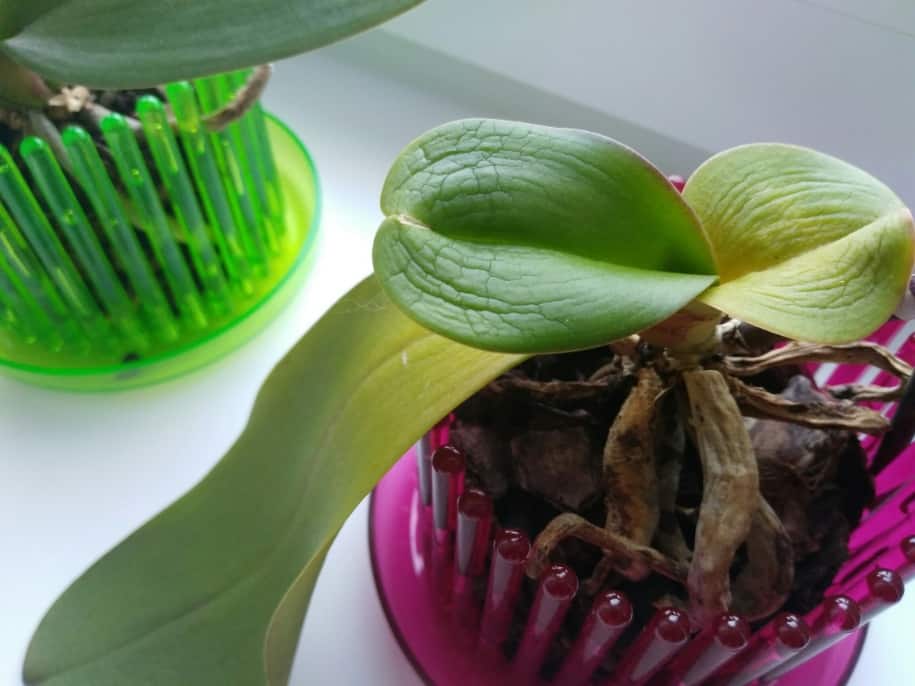

Outcome
Resuscitation of an orchid is a very troublesome process, so it is better to prevent the disease than to build new roots for a long time. However, it is quite difficult to fight fungal diseases, in some cases it is easier to cut off all diseased roots and grow new and good ones.
In any case, any florist will sooner or later face resuscitation, because you can always have time to throw out a plant, but to fight for its life, get a result and enjoy the flowering of rescued plants is worth a lot!
Have you come across the resuscitation of orchids in practice? Tell us about your methods!
Drying of air appendages
Identifying the cause
The appearance of roots in the aerial part of orchids is natural processas they are part of the food system. Their condition determines the development of the epiphyte: health, energy, strength, frequency and duration of flowering.
Damage or deterioration of air appendages threatens to dry out, which can lead to the complete death of an exotic pet. The manifestation of the unsuccessfulness of the above-ground food system requires immediate action.
Healthy aerial roots can be distinguished by the following:
- quite dense to the touch;
- fleshy structure;
- the surface is smooth;
- tight when pressed;
- have a silvery green or shades of it.
Wrinkles, oiliness, loss of density, dark spots or dark color require immediate action from the wearer.
What should I do?
If the aerial roots are dry, the first step is to find out the cause of this condition and try to immediately eliminate it. If the situation has not gone too deep, then you can do with a single pruning of damaged roots. If the condition is sufficiently neglected, a transplant should be urgently carried out, following the instructions of experienced orchid growers.
When to plant a plant in the ground?
Phalaenopsis can be transplanted into the substrate only after the roots have grown at least 3-5 mm.
- To do this, you need to take a flowerpot no more than 8 cm in diameter, so that the plant quickly absorbs water and dries out quickly.
It is better to use a peat pot, then in the future it will be necessary not to transplant the plant completely, but only to rearrange it in a new flowerpot and add a substrate. - When the roots are 7-8 cm long, you need to transplant the phalaenopsis into a larger pot and fix it on a support.
There are several diseases that can seriously harm an orchid. Mostly they are caused either by improper care or by pests. To avoid wilting of flowers and buds, sticky plaque and other problems with leaves, you need to follow preventive measures and inspect the flower.
Resuscitation in the absence of the underground part of the roots
If only aerial roots remain, and the lower part of the plant has undergone complete processing after the removal of putrefactive foci, has dried out enough, but the roots on it are completely absent, then there is an option of planting in a new container with the deepening of some aerial roots... Especially long roots should not be buried in the substrate, leaving them at the top to obtain food from the atmospheric air.
Orchid is a rather capricious, but very life-loving plant. While the underground part is being reanimated, the ground one will provide and support the life of the plant, receiving what it needs through the atmospheric air. And since many types of orchids can be propagated by cuttings of aerial roots, then when rooting, there is a chance that 4 out of 5 of these plants will take root.
Follow-up care
And now the plant has grown roots and gained turgor. But you should not relax: after the greenhouse conditions, the phalaenopsis needs to be accustomed to the dry air of the room. To do this, organize a new greenhouse: take a transparent bag or the bottom of a bottle. Put it on the plant for 5-6 hours a day so that it is 10 cm from the tips of the leaves to the bottom of the greenhouse. After a couple of weeks of this procedure, the orchid will fully adapt.
The orchid is susceptible to various diseases and pests. Read about sticky leaves, stains, drying out, leaf diseases, pests, and root care.
If you do everything according to the instructions, the orchid will quickly begin to recover.... And soon, by the flowering luxurious plant, it will be difficult to say that not so long ago this phalaenopsis died, completely devoid of roots!
If you find an error, please select a piece of text and press Ctrl + Enter.
Changing the type of substrate
The orchid "gets used" to the growing environment (substrate). When there are significant changes in this environment, the plant begins to grow other roots suitable for the new conditions.
The roots of an orchid that grew epiphytically or in a substrate of a large fraction, as a rule, are strong and resistant to drying out, in contrast to thick, soft roots that grew in sphagnum moss, peat or other moisture-intensive mixture. The roots of plants growing on / in sphagnum will not easily adapt to epiphytic conditions, and roots that grew epiphytic or in a coarse-grained substrate will not adapt to sphagnum. The roots will die off if there is a radical change in the type of substrate, although new roots will grow and adapt to any new environment.

